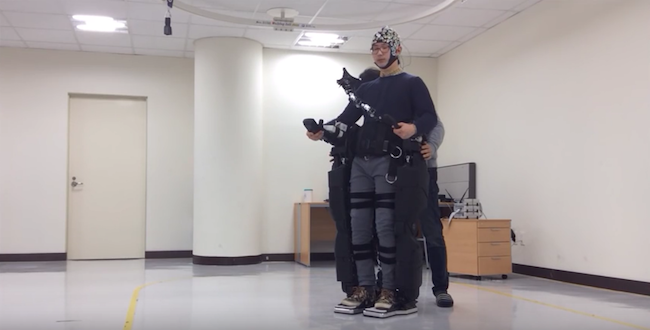New Robotic Exoskeleton Is Controlled by Human Thoughts

One big, robotic foot and then the other; that's how a man wearing a clunky-looking exoskeleton makes his way across the room. The machine's motors are noisy and its movements are painfully slow, but these details seem to fade into the background when you realize how the man is controlling the cumbersome contraption: He's doing it with his mind.
The exoskeleton — a robotic device that fits around the man's hips and legs — is part of a new technology being developed by researchers in Germany and Korea. The other part is a dark cap on the man's head, covered with electrodes that facilitate the connection between his brain and the machine.
The man wearing the exoskeleton in the experiment can walk on his own (he's one of the participants in the researchers' newly published study), but the scientists think their new mind-controlled device could one day be used by people who can't walk — such as those who have suffered severe spinal cord injuries, or people with neurodegenerative diseases, like amyotrophic lateral sclerosis (ALS). [Bionic Humans: Top 10 Technologies]
Lots of researchers are working to develop technologies that help people regain control over their movements through a combination of robotics and brainpower (formally known as brain-computer interface control systems).
In 2011, a woman who suffered a stroke that left her unable to move lifted a cup with a robotic arm that she manipulated with her thoughts. In 2012, another woman (this one a quadriplegic suffering from spinocerebellar degeneration) doled out a few high fives and ate a piece of chocolate using a similar, mind-controlled robotic arm.
But these technologies differ from the new brain-controlled exoskeletonin a very important way: In order to manipulate either of these robotic arms with their brains, the patients had to first undergo invasive brain surgery. Surgeons implanted tiny electronics into the patients' brain that, when connected to external wires, allowed the women to control the robotic arms using electrical impulses from their brains.
But the brain-computer interface developed by researchers at Korea University in Seoul, South Korea, and the Technical University (TU) of Berlin doesn't require brain surgery. In order to control the exoskeleton, study subjects first strap on the cap covered in small electrodes that cling to their scalps. The skullcaps are the tools that connect the subject's brain to the exoskeleton, the researchers said, and are commonly used in electroencephalograms (EEGs) — a method of recording electrical activity by placing conductive materials on the scalp (the brain waves are then plotted on a chart, much like heart rate).
Get the world’s most fascinating discoveries delivered straight to your inbox.
In the exoskeleton study, the EEG cap was used to pick up very particular brain signals — those created by what the researchers call steady-state visual evoked potentials (SSVEPs). Essentially, the electrodes detect "flashing lights," the researchers said.
A small controller jutting out from the exoskeleton holds a set of light-emitting diodes (LEDs) that light up in different patterns. The patterns represent specific commands that the exoskeleton can carry out, such as stand up, sit down, walk forward, turn left and turn right. [Super-Intelligent Machines: 7 Robotic Futures]
The person wearing the exoskeleton stares at one of these lights (for example, the one that corresponds to the command for taking a step forward). His brain produces a particular electrical signal in response to seeing the light. That signal is picked up by the electrode cap, which sends the brain signal information to a computer via a wireless connection. The computer then translates the brain signals into the appropriate command and sends that command to the exoskeleton. Within a few seconds, the exoskeleton takes a step forward.
The setup is "robust and intuitive," according to Klaus Müller, a professor in the computer science department at TU and lead author of the new paper outlining the research. The technology is considered robust because the interface still works even though the exoskeleton creates all kinds of electrical signals that could interfere with a person's brain signals. And it's intuitive because, despite all the steps involved in the brain-controlled process, it's actually pretty simple to get the exoskeleton to do what you want it to do, Müller told Live Science in an email.
But the brain-computer interface is not without its quirks. For one thing, all 12 participants in the study had to be screened for epilepsy before participating, and even Müller said that staring at the interface's flashing LEDs for extended periods of time gives him a headache.
In the future, the researchers hope to create a similar system that causes less "visual fatigue," Müller said. The other obstacle standing in the exoskeleton's way is cost.
Not only do the researchers need to conduct all kinds of expensive clinical studies before getting these devices anywhere near patients in the real world, the patients themselves will then have to pay for them. Getting insurance companies to cover the cost of this futuristic (but potentially life-altering) tech could be the hardest part of the process, Müller said.
Follow Elizabeth Palermo @techEpalermo. Follow Live Science @livescience, Facebook & Google+. Original article on Live Science.


